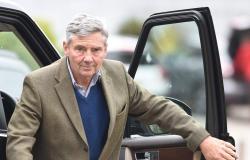Three years ago, the American photographer and writer Allen Frame (Mississippi, United States, 1953) published his second monograph, Fever, the candid portrait of a time lived with hope and camaraderie by a group of artists within the creative hotbed that was New York’s East Village in 1981. In a way, that year marked a before and after within that artistic community. Although it was still possible to pay $150 a month in rent, the subway had risen from 60 to 75 cents; IBM presented its first personal computer; Nan Goldin participated alongside Keith Haring, Basquiat, Robert Mapplethorpe and many other artists in New York / New Wave, one of the most decisive exhibitions of the time, held at MoMA PS1; and The New York Times He titled one of his articles: “A strange type of cancer observed in 41 homosexuals.”
“Happiness is a fictitious sensation. “Created by imaginative narrators with the purpose of constructing a plot and resolving the story,” said the actress and cinema muse years later. underground cookie muller, one of the protagonists of those moments of splendor captured by Frame’s camera, died in 1989 due to complications derived from AIDS. Hence, in order to recover the memory of those days lived fully, the photographer has once again used his archive to delve into the melancholic portrait of that lost generation. And, focusing, this time on a broader period of time, (from 1977, the year in which the photographer arrived in New York, until 1992) has shaped Whereupon (after which), his latest photobook, whose title implies a temporality; the fleeting joy that preceded the dramatic episodes experienced by a community decimated by AIDS.
Darrel Ellis, Cady Noland, Peter Hujar, Robert Gober and other lesser-known creators are part of the peaceful encounters between artists, writers and actors, both in soulless kitchens and behind the scenes of studios or in rooms decorated with their works. On cloudy days, they walk along the beach, sometimes sunbathing, other times having fun on rooftops, where the city takes on another dimension and the Twin Towers draw a horizon destined to disappear. Life and art merge into a single entity.
The monograph includes unpublished images of the theater performances in which part of that group of artists participated. During the long rehearsals, personal dramas often arose, however these would remain out of Frame’s viewfinder. “In 1981, I began to enter the world of theater,” says the photographer during a video conference. “I actually wanted to get closer to a series of actors who were considered cult characters in the world. downtown, and have the opportunity to photograph them, but what happened is that theater hooked me and two years later a group of friends decided to start a small theater company.” Frame would co-direct a series of monologues written by David Wojnarowicz, then unknown, later collected in a publication: Sound in the Distance. The performances took place in a garden at 13 East 3rd Street, where the actor and also painter Bill Rice lived, and a year later they premiered in Berlin, this time without the presence of Goldin, who usually participated as an actress and was presenting his now famous Ballad of sexual dependency through different places in Europe. In parallel, Frame was articulating his own visual diary, in which he would find his voice as a photographer, within a practice that, in France, the French critic Gilles Mora and the photographer Claude Nori called “photobiography.”.
Yes in Fever the photographer used only color, in Whereupon It is interspersed with black and white. It will be in the three color sections that make up the publication where the attentive reader will encounter a curious and subtle design resource, through which the first and last images of the series appear repeated and flipped, creating a kind of metaphor about the coming and going of time.
There is nothing casual in the making of the images, where the photographer’s formal decisions, the care in the composition and the search for the expressiveness of the body and gesture are visible, without losing the freshness of immediacy. Implicit in them is the author’s love for cinema and theater. Made with natural light, they are images impregnated with a subtle tension as well as loaded with ambiguity, where one cannot guess what is really happening. As happens in Butch and Fabio, NYC, 1979. “It is precisely this lack of definition that keeps the viewer’s gaze and makes it more interesting,” says Frame. “Because of the intimacy it gives off, one might think that there was more closeness between the characters than there really is. Fabio was visiting and was the boyfriend of Butch’s friend. And, Butch was my friend. Maybe the intimacy in that image has more to do with my relationship with her, Fabio is probably a kind of substitute for myself.”
Frame “does the improbable by using the medium of the still image to sustain a non-linear narrative, a narrative not explained but implicit,” wrote Goldin in the presentation of an exhibition by the photographer at the Polaris gallery in Paris. “He does not define his relationship with his friends—his subjects—as a series of moments of frozen time, but as a flow of experiences, interactions, and shared emotions. Through his images we experience the open nature of each moment, everything that has happened before and what will come after, the tension of the revelation of things not yet realized.
Whereupon It reflects Frame’s impulse not only to recover the memory of a group of creators but of a time. The reflection of “a life lived within art”, as the photographer warns. “Almost all of us were in our late twenties or early thirties. There were still many decisions to make in our lives and there was much more indefinition, frankness and openness to what was presented at each moment,” notes the photographer. Although part of the pleasure of the book comes from recognizing already established artists in it, it also comes from the unconsecrated ones; of the atmosphere of innocence, promises and hope that nourished the entire group. The myth of artistic bohemianism continues to be capable of feeding powerful narratives where art merges with life in a passionate and authentic search, outside of established norms. As a lively testimony of the past capable of reactivating the memory of what was lost and opening doors to the future.
‘Whereupon‘. Allen Frame. Palermo Publishing. 120 pages. 70 euros.
Subscribe to continue reading
Read without limits
_







